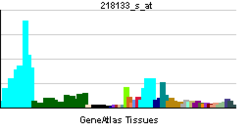- NIF3L1
-
NIF3 NGG1 interacting factor 3-like 1 (S. pombe) Identifiers Symbols NIF3L1; ALS2CR1; CALS-7 External IDs OMIM: 605778 MGI: 1929485 HomoloGene: 5881 GeneCards: NIF3L1 Gene Gene Ontology Molecular function • protein binding
• transcription factor bindingCellular component • cytoplasm
• mitochondrionBiological process • positive regulation of transcription, DNA-dependent Sources: Amigo / QuickGO RNA expression pattern 
More reference expression data Orthologs Species Human Mouse Entrez 60491 65102 Ensembl ENSG00000196290 ENSMUSG00000026036 UniProt Q9GZT8 Q3V2R8 RefSeq (mRNA) NM_001136039.2 NM_022988.2 RefSeq (protein) NP_001129511.1 NP_075364.2 Location (UCSC) Chr 2:
201.75 – 201.77 MbChr 1:
58.5 – 58.54 MbPubMed search [1] [2] NIF3-like protein 1 is a protein that in humans is encoded by the NIF3L1 gene.[1][2][3][4]
Interactions
NIF3L1 has been shown to interact with COPS2.[3]
References
- ^ Tascou S, Uedelhoven J, Dixkens C, Nayernia K, Engel W, Burfeind P (Jan 2001). "Isolation and characterization of a novel human gene, NIF3L1, and its mouse ortholog, Nif3l1, highly conserved from bacteria to mammals". Cytogenet Cell Genet 90 (3–4): 330–6. doi:10.1159/000056799. PMID 11124544.
- ^ Hadano S, Yanagisawa Y, Skaug J, Fichter K, Nasir J, Martindale D, Koop BF, Scherer SW, Nicholson DW, Rouleau GA, Ikeda J, Hayden MR (Feb 2001). "Cloning and characterization of three novel genes, ALS2CR1, ALS2CR2, and ALS2CR3, in the juvenile amyotrophic lateral sclerosis (ALS2) critical region at chromosome 2q33-q34: candidate genes for ALS2". Genomics 71 (2): 200–13. doi:10.1006/geno.2000.6392. PMID 11161814.
- ^ a b Akiyama H, Fujisawa N, Tashiro Y, Takanabe N, Sugiyama A, Tashiro F (Mar 2003). "The role of transcriptional corepressor Nif3l1 in early stage of neural differentiation via cooperation with Trip15/CSN2". J Biol Chem 278 (12): 10752–62. doi:10.1074/jbc.M209856200. PMID 12522100.
- ^ "Entrez Gene: NIF3L1 NIF3 NGG1 interacting factor 3-like 1 (S. pombe)". http://www.ncbi.nlm.nih.gov/sites/entrez?Db=gene&Cmd=ShowDetailView&TermToSearch=60491.
Further reading
- Maruyama K, Sugano S (1994). "Oligo-capping: a simple method to replace the cap structure of eukaryotic mRNAs with oligoribonucleotides". Gene 138 (1–2): 171–4. doi:10.1016/0378-1119(94)90802-8. PMID 8125298.
- Suzuki Y, Yoshitomo-Nakagawa K, Maruyama K et al. (1997). "Construction and characterization of a full length-enriched and a 5'-end-enriched cDNA library". Gene 200 (1–2): 149–56. doi:10.1016/S0378-1119(97)00411-3. PMID 9373149.
- Strausberg RL, Feingold EA, Grouse LH et al. (2003). "Generation and initial analysis of more than 15,000 full-length human and mouse cDNA sequences". Proc. Natl. Acad. Sci. U.S.A. 99 (26): 16899–903. doi:10.1073/pnas.242603899. PMC 139241. PMID 12477932. http://www.pubmedcentral.nih.gov/articlerender.fcgi?tool=pmcentrez&artid=139241.
- Tascou S, Kang TW, Trappe R et al. (2003). "Identification and characterization of NIF3L1 BP1, a novel cytoplasmic interaction partner of the NIF3L1 protein". Biochem. Biophys. Res. Commun. 309 (2): 440–8. doi:10.1016/j.bbrc.2003.07.008. PMID 12951069.
- Ota T, Suzuki Y, Nishikawa T et al. (2004). "Complete sequencing and characterization of 21,243 full-length human cDNAs". Nat. Genet. 36 (1): 40–5. doi:10.1038/ng1285. PMID 14702039.
- Merla G, Howald C, Antonarakis SE, Reymond A (2005). "The subcellular localization of the ChoRE-binding protein, encoded by the Williams-Beuren syndrome critical region gene 14, is regulated by 14-3-3". Hum. Mol. Genet. 13 (14): 1505–14. doi:10.1093/hmg/ddh163. PMID 15163635.
- Gerhard DS, Wagner L, Feingold EA et al. (2004). "The Status, Quality, and Expansion of the NIH Full-Length cDNA Project: The Mammalian Gene Collection (MGC)". Genome Res. 14 (10B): 2121–7. doi:10.1101/gr.2596504. PMC 528928. PMID 15489334. http://www.pubmedcentral.nih.gov/articlerender.fcgi?tool=pmcentrez&artid=528928.
- Rual JF, Venkatesan K, Hao T et al. (2005). "Towards a proteome-scale map of the human protein-protein interaction network". Nature 437 (7062): 1173–8. doi:10.1038/nature04209. PMID 16189514.
- Lim J, Hao T, Shaw C et al. (2006). "A protein-protein interaction network for human inherited ataxias and disorders of Purkinje cell degeneration". Cell 125 (4): 801–14. doi:10.1016/j.cell.2006.03.032. PMID 16713569.
Categories:- Human proteins
- Chromosome 2 gene stubs
Wikimedia Foundation. 2010.
